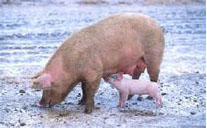
It should come as no surprise that recent research supports what older generations of pig farmers knew all along. Pigs on dirt do better than pigs in confinement. If you add antibiotics to the ration of confined pigs the disparity is even more pronounced.

The study found that 90% of bacteria in the guts of the outdoor piglets came from
the phylum Firmicutes. Most of these were lactobacillaceae, known for their health-promoting effects, and for their ability to limit intestinal pathogens such as Escherichia coli and Salmonella. In contrast, the Firmicutes bacteria made up less than 70% and just more than 50% of the gut flora in indoor and isolated bred pigs respectively. The pigs also had much smaller proportions of bacteria from the lactobacillaceae family.
The team also found that the gut microbial communities in outdoor raised pigs benefited the expression of genes associated with the piglets’ immune system.
Read more below, or at this link.
Dirty pigs are healthy pigs
Study finds link between outdoor living and immune health.
From nature.com
Living like a pig could be good for you. Research has shown how dirty piglets obtain ‘friendly’ bacteria that help them to develop healthy immune systems later in life.
The results, published online in BMC Biology1, provide the first direct link between dirty living, immune health and genetic expression. They also indicate that manipulating gut bacteria early in life might reduce allergies and other autoimmune diseases, says Denise Kelly, a gut immunologist at the University of Aberdeen, UK and one of the study’s authors.
Researchers began with 54 piglets and divided them equally between an outdoor environment, an indoor environment, and an isolated environment where they were fed antibiotics on a daily basis. The scientists then killed piglets on days 5 (neonatal stage), 28 (weaning age), and 56 (nearing maturity) to study their gut tissue and faeces.
The study found that 90% of bacteria in the guts of the outdoor piglets came from the phylum Firmicutes. Most of these were lactobacillaceae, known for their health-promoting effects, and for their ability to limit intestinal pathogens such as Escherichia coli and Salmonella. In contrast, the Firmicutes bacteria made up less than 70% and just more than 50% of the gut flora in indoor and isolated bred pigs respectively. The pigs also had much smaller proportions of bacteria from the lactobacillaceae family.
Wallowing benefits
The team also found that the differences in gut microbial communities affected the expression of genes associated with the piglets' immune system. Animals raised in the isolated environment expressed more genes involved in inflammatory immune responses and cholesterol synthesis, whereas genes associated with T cells were expressed in the outdoor-reared pigs.
Kelly says that until now, the link between living environment and immune response had been circumstantial. "There has been a lot of hearsay around gut microbiota and how it influences immune function and susceptibility to diseases and allergies," she says. The latest work establishes a strong causal link.
Glenn Gibson, a food microbiologist at the University of Reading, UK, agrees that previous studies have "shown by implication" that immune responses are linked to organisms in the gut. "This study takes a step forwards by tallying the gene expression response into this," he says.
However, he adds that because the study was carried out in pigs, there is no way to be certain that the results are relevant to humans.
Kelly argues that the similarities between the organisms found in human and pig guts and their comparable size in organs, makes pigs a good model animal to study. In future studies, she hopes to further identify the types of organisms that are associated with health.
References:
1. Mulder, I. E. et al. BMC Biol. 7, 79 (2009).
